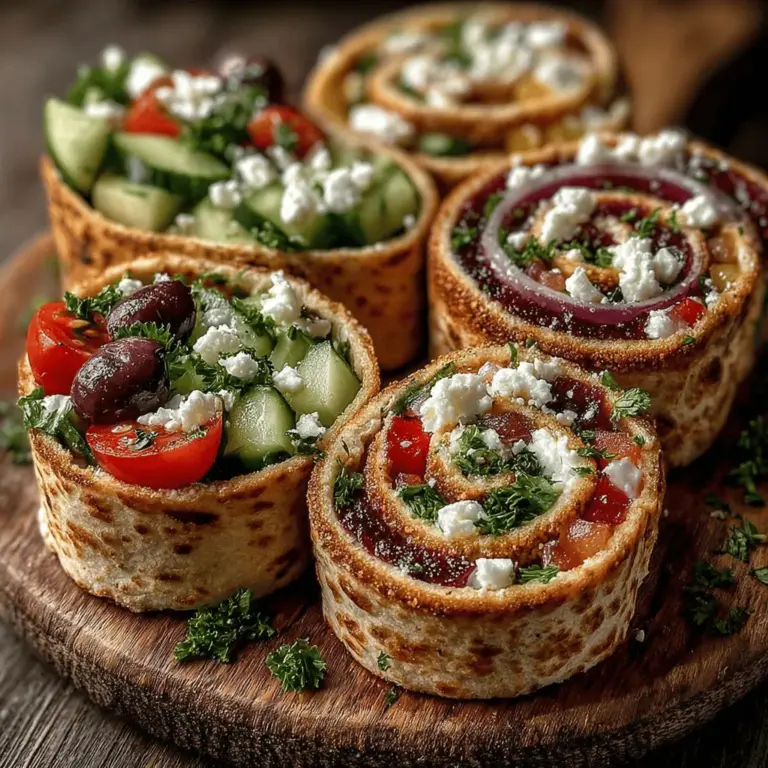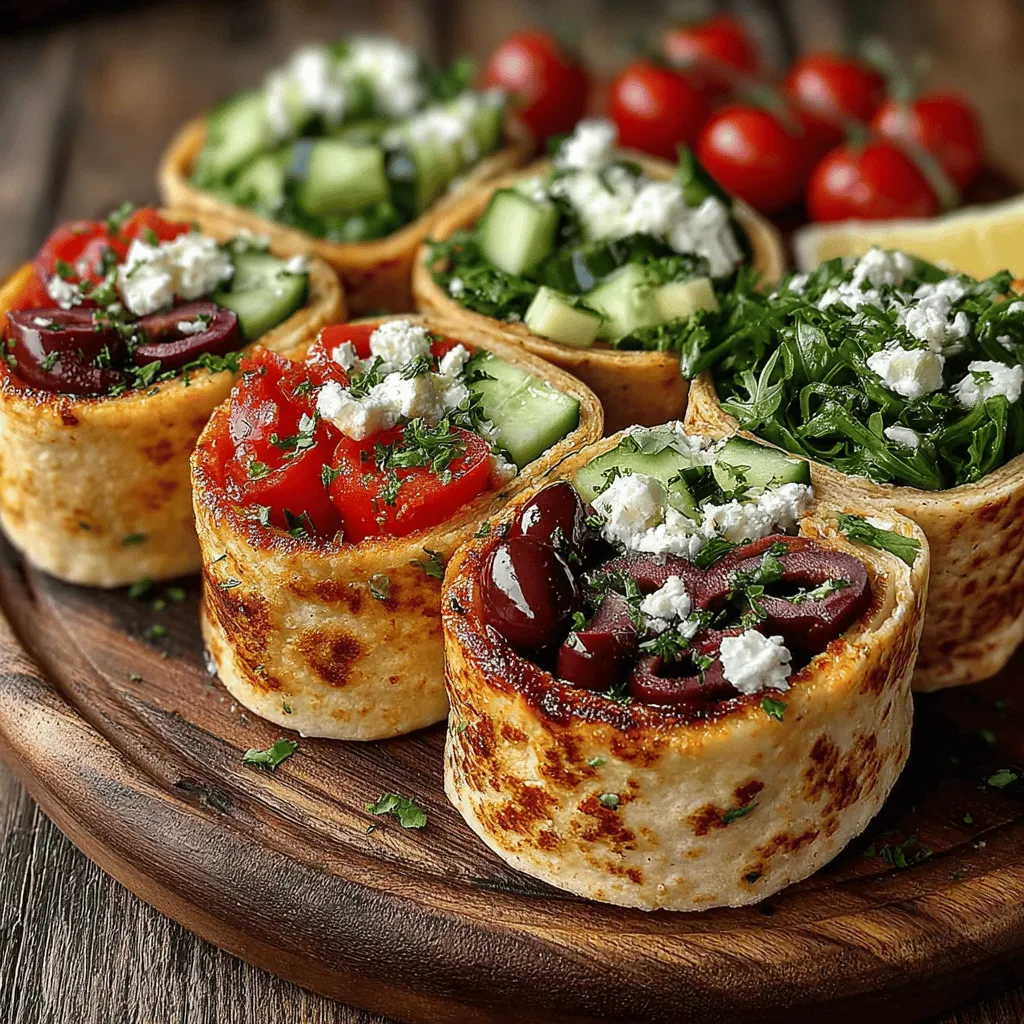Mini Mediterranean Hummus Wraps: A Flavorful and Nutritious Delight
Mediterranean cuisine has gained immense popularity over the years, celebrated not only for its rich flavors but also for its health benefits. The Mediterranean diet, which emphasizes whole foods, healthy fats, and fresh vegetables, is often lauded for its potential to improve heart health, support weight management, and enhance overall well-being. This culinary tradition is rooted in the diverse cultures surrounding the Mediterranean Sea, where ingredients are fresh, seasonal, and bursting with flavor.
Among the many delightful dishes that this cuisine offers, Mini Mediterranean Hummus Wraps stand out as an ideal meal option for those seeking a quick, nutritious, and satisfying bite. Whether you’re on the go, packing a lunch for work, or hosting a casual gathering, these wraps are incredibly versatile. Not only can they be customized to suit various tastes, but they also make for an appealing dish that can cater to both vegetarians and meat-eaters alike.
In this article, we will explore the delicious world of Mini Mediterranean Hummus Wraps, diving into the essential ingredients that make this recipe shine, as well as the preparation steps to ensure a delightful culinary experience.
Understanding the Ingredients
The heart of any great recipe lies in its ingredients, and Mini Mediterranean Hummus Wraps are no exception. Let’s take a closer look at the key components that contribute to both the taste and nutritional profile of this dish.
Whole Wheat Tortillas or Pita Bread
At the base of our wraps, we can choose between whole wheat tortillas or pita bread. Whole wheat tortillas are an excellent source of complex carbohydrates, fiber, and essential nutrients. They provide a wholesome foundation that not only holds the filling but also adds a nutty flavor to the dish. Pita bread, on the other hand, offers a unique texture and is a traditional accompaniment in Mediterranean cuisine. Both options are healthy choices, contributing to a balanced meal.
Hummus: A Protein-Rich Base
Hummus serves as the star ingredient in our wraps, bringing creaminess and depth of flavor. Made primarily from chickpeas, tahini, garlic, lemon juice, and olive oil, hummus is not only delicious but also packed with plant-based protein and fiber. Incorporating hummus into your diet can help keep you feeling full and satisfied, making it an excellent choice for a light lunch or snack.
Fresh Vegetables
The freshness of the vegetables is crucial in achieving a vibrant wrap. Key ingredients include crunchy cucumbers, sweet cherry tomatoes, zesty red onion, briny olives, and a mix of leafy greens such as spinach or arugula. Each vegetable adds its own unique flavor and texture, contributing to a well-rounded taste profile. Cucumbers provide a refreshing crunch, while cherry tomatoes offer a burst of sweetness. Red onions add a sharp bite, and olives bring a salty richness that perfectly complements the other components. Lastly, the greens not only enhance the flavor but also pack in essential vitamins and minerals.
Feta Cheese
Feta cheese is a staple in Mediterranean dishes, known for its crumbly texture and tangy flavor. Adding feta to our wraps introduces a creamy element that elevates the overall taste. It pairs beautifully with the other ingredients, providing a contrast to the freshness of the vegetables and the richness of the hummus. Feta cheese is also a good source of calcium and protein, making it a nutritious addition to our wraps.
Lemon Juice and Olive Oil
The finishing touch for our Mini Mediterranean Hummus Wraps comes from a simple drizzle of lemon juice and olive oil. Lemon juice brightens the flavors, adding a zesty kick that enhances the overall taste profile. Olive oil, a staple in Mediterranean cooking, is rich in monounsaturated fats, which are beneficial for heart health. This combination not only improves the flavor but also contributes to the health benefits of the dish.
Preparation Steps
Now that we have a solid understanding of the key ingredients, it’s time to dive into the preparation steps. A well-prepared wrap is all about balance and freshness, so let’s ensure we take the necessary steps to create a delightful dish.
Washing and Chopping Fresh Vegetables
Start by washing all your fresh vegetables thoroughly under cold running water. This is a crucial step to remove any dirt or pesticides. For optimal results, use a vegetable brush on firmer produce like cucumbers. Once clean, it’s time to chop the vegetables.
– Cucumbers: Cut them in half lengthwise, then slice into thin half-moons for easy layering in the wrap.
– Cherry Tomatoes: Halve them to release their juices and enhance their sweetness.
– Red Onion: Slice thinly to allow their sharpness to mellow slightly when combined with the other ingredients.
– Olives: If you’re using whole olives, pit and slice them for easy incorporation throughout the wrap.
– Greens: Rinse your leafy greens and gently pat them dry. If using larger leaves, tear them into manageable pieces.
Freshness is key here; the more vibrant and crisp your vegetables are, the better your wraps will taste.
Mixing the Filling
With your vegetables prepped, it’s time to mix the filling. In a large bowl, combine the chopped cucumbers, cherry tomatoes, red onion, olives, and greens. This is where you can get creative; feel free to adjust the ratios of each vegetable to suit your taste preferences. Gently toss the ingredients together to ensure even distribution.
When mixing, it’s essential to maintain the integrity of the greens. Use your hands or a spatula to fold the ingredients together rather than stirring vigorously, which can bruise the delicate leaves.
Spreading Hummus
Next, we’ll move on to spreading the hummus on the base of your tortilla or pita bread. For even coverage, use a spatula or the back of a spoon to spread a generous layer of hummus across the entire surface. This not only adds flavor but also helps to hold the fillings in place. If you prefer a thicker spread, feel free to add more hummus, but ensure that it doesn’t compromise the overall balance of the wrap.
Choosing the Right Consistency of Hummus
When it comes to hummus, you have options. Store-bought hummus is convenient, but homemade hummus allows for customization in flavor and texture. If you opt for store-bought, look for varieties with minimal additives. If you decide to make your own, you can experiment with different spices, herbs, or even roasted garlic to create a unique flavor profile that suits your palate.
In the next section, we will explore the exciting assembly process for our Mini Mediterranean Hummus Wraps, ensuring that each element comes together to create a delicious and eye-catching dish.
Step-by-Step Guide on Layering the Filling
To create the perfect Mini Mediterranean Hummus Wraps, proper layering is essential. Start by preparing your fillings, which typically include fresh vegetables, hummus, and optional proteins. Here’s how to layer them effectively:
1. Spread the Hummus: Begin by spreading a generous layer of hummus on your chosen wrap—whether it’s a tortilla or pita bread. Leave about an inch of space around the edges. This not only prevents spillage but also allows the wrap to close securely.
2. Add Fresh Vegetables: Layer your chosen vegetables next. Options include sliced cucumbers, cherry tomatoes, shredded carrots, and bell peppers. Aim to place them in a line down the center of the wrap, ensuring they are evenly distributed.
3. Include Cheese or Proteins: If you’re adding feta cheese or a protein source like grilled chicken or chickpeas, sprinkle them over the vegetables. This layering technique ensures that each bite is packed with flavor and texture.
4. Herbs and Seasoning: For an added burst of flavor, sprinkle some fresh herbs like parsley or dill on top. A pinch of salt and pepper can enhance the taste of your fillings.
5. Avoid Overfilling: It’s crucial to leave some space at the top and bottom of the wrap to facilitate easy rolling. Overfilling may lead to messy wraps that are difficult to manage.
Rolling Techniques for Tortillas Versus Pita Bread
Rolling techniques vary slightly between tortillas and pita bread. Here’s how to roll them correctly:
For Tortillas:
1. Fold the Sides: Begin by folding the sides of the tortilla inward, about an inch, to contain the filling.
2. Start Rolling: Hold the folded sides and roll the tortilla away from you, tucking the filling in as you go. Keep the roll tight but not so tight that it bursts.
3. Secure the Wrap: Once fully rolled, you can use a toothpick to secure the wrap or wrap it in parchment paper for serving.
For Pita Bread:
1. Fill the Pocket: With pita bread, you won’t need to roll. Instead, cut the bread in half to create pockets and carefully stuff them with your fillings.
2. Press Gently: Make sure to press gently to avoid tearing the pita while ensuring it’s filled adequately.
Tips for Securing the Wraps
To ensure your Mini Mediterranean Hummus Wraps hold together during serving, consider the following tips:
– Use Toothpicks: Inserting a toothpick into each wrap can help keep everything in place, especially if you have a lot of fillings.
– Wrap in Parchment Paper: This not only makes for an attractive presentation but also holds everything together during transport.
– Chill Before Serving: If you have time, refrigerating the wraps for about 30 minutes can help them firm up, making them easier to slice and serve.
Serving Suggestions
Presenting your Mini Mediterranean Hummus Wraps attractively can enhance the dining experience. Here are some serving suggestions:
– Slicing: Cut each wrap diagonally in half to showcase the colorful filling. Arrange the halves on a platter for a beautiful display.
– Garnishing: Drizzle a little olive oil over the wraps and sprinkle with fresh parsley for an appealing finish.
– Pairing Options: Complement your wraps with side dishes like a Greek salad, quinoa tabbouleh, or roasted vegetables. For drinks, consider serving with a light white wine, sparkling water with lemon, or a refreshing iced tea.
– Dips and Sauces: Enhance your wraps with dips such as tzatziki, baba ganoush, or a spicy harissa sauce. These add layers of flavor and variety to your meal.
Nutritional Information
Understanding the nutritional profile of your Mini Mediterranean Hummus Wraps can help you appreciate their health benefits:
– Calories and Nutritional Benefits: Each wrap typically contains around 250-300 calories, depending on the ingredients used. They are rich in fiber from vegetables and hummus, providing a satisfying meal without excessive calories.
– Balanced Diet Compatibility: These wraps fit well into a balanced diet, offering healthy fats from olive oil, protein from hummus and optional proteins, and a variety of vitamins from fresh vegetables.
– Customization for Dietary Preferences: The recipe is highly adaptable, making it suitable for different dietary needs. Use gluten-free wraps for a gluten-free option or substitute dairy-based cheese with vegan alternatives for a plant-based version.
Variations and Customizations
Exploring different ingredient swaps can personalize your Mini Mediterranean Hummus Wraps to suit your taste preferences:
– Ingredient Swaps: Try different vegetables based on what you have on hand or what’s in season. Consider adding roasted red peppers, zucchini, or arugula for varied flavors.
– Vegan Cheese Options: If you prefer a dairy-free wrap, replace feta cheese with vegan cheese options made from almonds or cashews, or simply omit it altogether for a lighter wrap.
– Seasonal Vegetables: Incorporating seasonal vegetables not only enhances flavor but also adds nutritional variety. Think of adding asparagus in spring or roasted butternut squash in the fall.
– Adding Protein: For a heartier wrap, consider including grilled chicken slices, roasted chickpeas, or even falafel. Each of these additions can elevate the protein content and make the meal more filling.
Conclusion
Mini Mediterranean Hummus Wraps are a delightful, healthy option for any meal, offering a perfect blend of flavors and textures. They’re not just easy to prepare but are also versatile, allowing you to experiment with a range of ingredients to suit your palate.
Encourage yourself to try different combinations and make the recipe your own. Embracing Mediterranean flavors and fresh ingredients in your meals not only enhances your culinary repertoire but also contributes to healthier eating habits. Get creative with your fillings, enjoy the vibrant flavors, and share these delicious wraps with family and friends for a wholesome dining experience.


